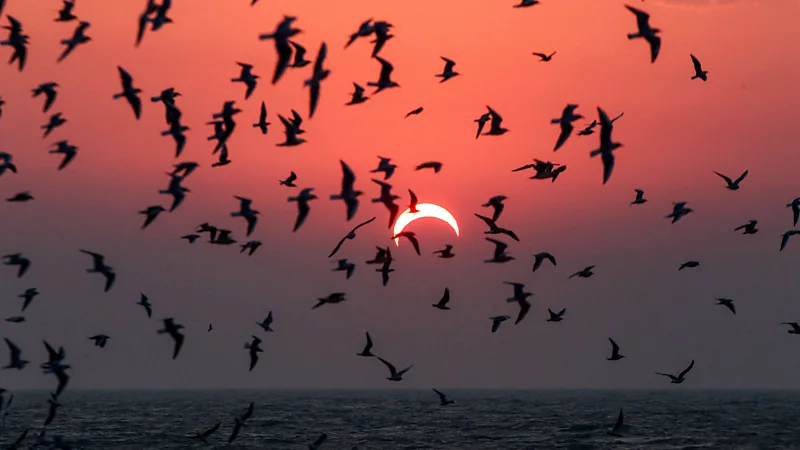Solar eclipses affect the animal world, too
 Solar eclipses captivate humans with their rare and dramatic display as the moon briefly obscures the sun, casting darkness in the middle of the day. This phenomenon invokes feelings of awe and wonder among people, but how animals perceive and react to this sudden change remains uncertain.
Solar eclipses captivate humans with their rare and dramatic display as the moon briefly obscures the sun, casting darkness in the middle of the day. This phenomenon invokes feelings of awe and wonder among people, but how animals perceive and react to this sudden change remains uncertain.
Animals, like humans, follow a 24-hour biological rhythm, regulating their daily activities such as sleep, feeding, and hunting. However, the impact of solar eclipses on these ingrained routines is not thoroughly understood due to the rarity of such events, occurring approximately once every 400 years in a given location, and the variability in animal responses.
Cecilia Nilsson, a behavioural ecologist at Lund University in Sweden, highlights the significance of light as a crucial cue affecting the behavior of various organisms, from plants to animals. Solar eclipses provide researchers with a unique opportunity to study the effects of sudden darkness on animal behavior, offering insights into how these disruptions may influence their daily activities.
Over a century ago, an entomologist named William Wheeler conducted an experiment during a solar eclipse in 1932, aiming to observe the effects of the sun's disappearance on animal behavior. Wheeler enlisted the help of the public by placing advertisements in local newspapers, urging them to report any observed changes in animal behavior during the eclipse. He collected over 500 accounts documenting alterations in the behavior of birds, mammals, insects, and plants, such as owls beginning to hoot and bees returning to their hives.
In August 2017, a total solar eclipse lasting two minutes and 42 seconds provided scientists with an opportunity to replicate Wheeler's experiment. This time, the results were even more surprising. As darkness descended, unexpected behaviors were observed: giraffes became agitated and raced about nervously, tortoises engaged in mating behavior at a South Carolina zoo, and bumblebees ceased buzzing in states like Oregon, Idaho, and Missouri.
With the next solar eclipse set for Monday, April 8, curiosity has once again been sparked. This upcoming eclipse will traverse a narrow strip of land stretching from Mexico to Maine. Scientists are eager to closely observe the path of totality and are encouraging people to take note of any mysterious behaviors exhibited by animals during this celestial event.
The zoo was bonkers that day
Adam Hartstone-Rose, a scientist affiliated with the Riverbanks Zoo and Garden in South Carolina, initially believed that the zoo's inhabitants would not be affected by the 2017 eclipse, likening it to passing clouds or a rainstorm. However, both trained researchers and numerous citizen scientists gathered at the zoo to observe 17 species before and after the eclipse. Hartstone-Rose describes the atmosphere at the zoo on that day as "remarkable," with thousands of excited visitors present.
According to Hartstone-Rose, more than three-quarters of the observed animals exhibited a noticeable reaction to the "amazing" and "life-changing" event. The reactions were classified into four categories: animals behaving normally, those adhering to their evening routines, animals displaying signs of anxiety, and those exhibiting novel behaviors.
For some animals, such as grizzly bears, the eclipse elicited little to no response. Hartstone-Rose describes them as "totally nonchalant" throughout the experience, with some even appearing to be sleeping or lounging. He recalls one grizzly bear nonchalantly flopping its head over during totality, seemingly to emphasize its indifference to the celestial event.
Contrary to their typical behavior, nocturnal birds, such as tawny frogmouths, appeared perplexed by the eclipse. These birds, known for their mastery of camouflage, abandoned their daytime disguise to forage for food during the eclipse's peak, only to resume their tree stump-like appearance when the sun reappeared. However, some animals exhibited signs of distress during the eclipse. Giraffes, usually calm creatures, reacted as if startled by a predator or vehicle, running about nervously. Similar behavior was observed in giraffes at the Nashville Zoo in Tennessee.
However, some animals exhibited signs of distress during the eclipse. Giraffes, usually calm creatures, reacted as if startled by a predator or vehicle, running about nervously. Similar behavior was observed in giraffes at the Nashville Zoo in Tennessee.
The most peculiar behavior was observed in Galapagos giant tortoises, typically sedentary animals. Leading up to the eclipse, they became unusually active and expressive, even engaging in spontaneous mating at the height of totality.
While observing the eclipse at the zoo provided a unique opportunity to witness various animal reactions, there were challenges. The excitement of the eclipse led to loud and boisterous behavior from visitors, potentially influencing animal responses. Hartstone-Rose notes the difficulty in determining whether animal distress stemmed from the eclipse itself or the spectacle of human reactions to it.
In the wild
Nilsson, who spearheaded the study, utilized data from 143 weather stations spanning the entire USA, from the east coast to the west coast. This network of weather stations provided a unique opportunity to investigate the effects of rare events like solar eclipses on a large scale.
Scientists aimed to determine whether flying animals, such as birds and insects, would react to the eclipse by flocking to the sky, potentially mistaking the change in light for sunset. However, tracking individual birds during the darkness of the eclipse proved challenging. The solution came from using weather stations to monitor overall biological activity in the air.
Instead of tracking individual birds, the researchers utilized radar technology to measure the amount of biological material in the air, known as reflectivity. This method allowed them to assess changes in bird and insect activity during the eclipse.
Traditionally, at sunset, bird activity in the sky peaks as birds begin their nighttime migration. The researchers hypothesized whether the abnormal darkness during the day would serve as an environmental cue for birds to adjust their behavior.
Contrary to expectations, the study revealed a decrease in the amount of birds in the air leading up to the eclipse. Many birds landed or ceased flying altogether before the eclipse occurred. One hypothesis suggested that this behavior resembled birds seeking shelter in anticipation of an approaching storm.
Secondary-effects
 In the Platte River Valley of Nebraska, a critical nesting site and migratory bird stopover, researchers found it easier to observe behavioral patterns during the 2017 eclipse. However, birds displayed diverse reactions, according to Emma Brinley Buckley, a researcher from the University of Nebraska at Kearney. Western meadowlarks, for instance, grew silent or completely ceased their calls at 95% obscuration, while American goldfinches and song sparrows intensified their vocalizations during totality.
In the Platte River Valley of Nebraska, a critical nesting site and migratory bird stopover, researchers found it easier to observe behavioral patterns during the 2017 eclipse. However, birds displayed diverse reactions, according to Emma Brinley Buckley, a researcher from the University of Nebraska at Kearney. Western meadowlarks, for instance, grew silent or completely ceased their calls at 95% obscuration, while American goldfinches and song sparrows intensified their vocalizations during totality.
Like humans, animals exhibit varied responses to eclipses. For instance, fish seek shelter and spiders dismantle their webs as totality approaches. In a recent study, bumblebees suspended among flowers ceased buzzing when darkness fell.
However, not all changes can be attributed solely to light. Secondary effects of a total eclipse, such as temperature drops and increased humidity, also play a role. In Nebraska, temperatures dropped by approximately 6.7 degrees Celsius (12°F) and humidity rose by 12% during the eclipse, which is a significant change within a short time frame.
According to Brinley Buckley, pinpointing the exact cause of behavioral changes is challenging due to the combined effects of reduced solar illumination, temperature fluctuations, and changes in wind patterns.
Get involved
In April, the Riverbank Zoo in South Carolina plans to expand their monitoring efforts with a larger citizen science study. Adam Hartstone-Rose explains that the Solar Eclipse Safari project aims to accommodate various participation preferences, whether individuals prefer to observe quietly, with friends, or as a contribution to science. The project encourages thousands of people to observe animal behavior, extending beyond zoos to include farm animals and pets.
Preliminary data from an annular eclipse in October 2023 has already been collected. Unlike a total solar eclipse, an annular eclipse occurs when the Moon partially blocks the Sun, resulting in a "ring of fire" effect.
Nasa's Eclipse Soundscapes project involves nearly 1,000 data collectors scattered across the US. Participants utilize small audio recorders called AudioMoths to capture wildlife sounds during the eclipse. Henry Trae Winter, a solar physicist, notes the project's focus on identifying any lingering effects of eclipse-related sounds on animals. Understanding how animals respond to unusual stimuli could provide insights into human-induced disturbances, such as those caused by logging or constant artificial lighting from construction sites.
With this upcoming eclipse being the last total solar eclipse visible from the United States until 2044, many people will be closely observing animal reactions. Hartstone-Rose emphasizes the significance of eclipses as powerful shared experiences that connect us with each other and the natural world, fostering contemplation of broader questions.








































































